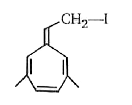Most reactive halide towards SN1 reactions is
n-butyl chloride
sec-butyl chloride
tert -butyl chloride
Allyl chloride
The correct Answer is:C
To determine the most reactive halide towards SN1 reactions, we need to analyze the stability of the carbocations formed during the reaction. The stability of the carbocation is crucial because the more stable the carbocation, the more reactive the halide will be in an SN1 reaction.
1. Understanding SN1 Mechanism:
- The SN1 (Substitution Nucleophilic Unimolecular) reaction involves the formation of a carbocation intermediate after the leaving group (in this case, a halide) departs. The stability of this carbocation is key to determining the reactivity of the halide.
Hint: Recall that the stability of carbocations increases with the degree of substitution (tertiary > secondary > primary).
2. Analyzing the Given Halides:
- N-butyl chloride (1-chlorobutane):
- Structure: CH3-CH2-CH2-CH2-Cl
- Upon losing Cl, it forms a primary carbocation (CH3-CH2-CH2-CH2+), which is the least stable.
Hint: Identify the type of carbocation formed from each halide.
- Secondary butyl chloride (2-chlorobutane):
- Structure: CH3-CH2-CH(Cl)-CH3
- Upon losing Cl, it forms a secondary carbocation (CH3-CH2-CH+-CH3), which is more stable than a primary carbocation but less stable than a tertiary one.
Hint: Compare the stability of primary vs. secondary carbocations.
- Tertiary butyl chloride (t-butyl chloride):
- Structure: (CH3)3C-Cl
- Upon losing Cl, it forms a tertiary carbocation ((CH3)3C+), which is quite stable due to hyperconjugation and inductive effects from the three methyl groups.
Hint: Remember that tertiary carbocations are the most stable among the three types.
- Allyl chloride:
- Structure: CH2=CH-CH2-Cl
- Upon losing Cl, it forms an allylic carbocation (CH2=CH-CH2+). This carbocation is stabilized by resonance, making it even more stable than a tertiary carbocation.
Hint: Consider the effect of resonance on carbocation stability.
3. Comparing Stability:
- Stability Order:
- Allylic carbocation > Tertiary carbocation > Secondary carbocation > Primary carbocation.
- Therefore, allylic chloride is the most reactive halide towards SN1 reactions because it forms the most stable carbocation.
4. Conclusion:
- Based on the analysis, the most reactive halide towards SN1 reactions is allyl chloride.
Final Answer:
Allyl chloride is the most reactive halide towards SN1 reactions.
- The SN1 (Substitution Nucleophilic Unimolecular) reaction involves the formation of a carbocation intermediate after the leaving group (in this case, a halide) departs. The stability of this carbocation is key to determining the reactivity of the halide.
- N-butyl chloride (1-chlorobutane):
- Structure: CH3-CH2-CH2-CH2-Cl
- Upon losing Cl, it forms a primary carbocation (CH3-CH2-CH2-CH2+), which is the least stable.
- Structure: CH3-CH2-CH(Cl)-CH3
- Upon losing Cl, it forms a secondary carbocation (CH3-CH2-CH+-CH3), which is more stable than a primary carbocation but less stable than a tertiary one.
- Structure: (CH3)3C-Cl
- Upon losing Cl, it forms a tertiary carbocation ((CH3)3C+), which is quite stable due to hyperconjugation and inductive effects from the three methyl groups.
- Structure: CH2=CH-CH2-Cl
- Upon losing Cl, it forms an allylic carbocation (CH2=CH-CH2+). This carbocation is stabilized by resonance, making it even more stable than a tertiary carbocation.
- Stability Order:
- Allylic carbocation > Tertiary carbocation > Secondary carbocation > Primary carbocation.
- Therefore, allylic chloride is the most reactive halide towards SN1 reactions because it forms the most stable carbocation.
- Based on the analysis, the most reactive halide towards SN1 reactions is allyl chloride.
Allyl chloride is the most reactive halide towards SN1 reactions.
Topper's Solved these Questions
- HALOALKANES AND HALOARENES BOOK - AAKASH INSTITUTE ENGLISHCHAPTER - HALOALKANES AND HALOARENES EXERCISE - ASSIGNMENT SECTON - A
45 Videos
- HALOALKANES AND HALOARENES BOOK - AAKASH INSTITUTE ENGLISHCHAPTER - HALOALKANES AND HALOARENES EXERCISE - ASSIGNMENT SECTION - B
25 Videos
- HALOALKANES AND HALOARENES BOOK - AAKASH INSTITUTE ENGLISHCHAPTER - HALOALKANES AND HALOARENES EXERCISE - Try Yourself
40 Videos
- GENERAL PRINCIPLES AND PROCESSES OF ISOLATION OF ELEMENTSBOOK - AAKASH INSTITUTE ENGLISHCHAPTER - GENERAL PRINCIPLES AND PROCESSES OF ISOLATION OF ELEMENTSEXERCISE - Try Yourself
33 Videos
- HYDROCARBONSBOOK - AAKASH INSTITUTE ENGLISHCHAPTER - HYDROCARBONSEXERCISE - Assignment(Section - C) (Previous Years Questions)
60 Videos
Similar Questions
Knowledge Check
Most reactive compound toward SN1 is :
A B
B C
C D
D
In the given pair of reaction in which pair the second reaction is more reactive than first toward SN2 reaction ?
ACH3−CH2−Cl+CH3−CH2−O−→Et−O−E (or)
CH2−CH2−Cl+CH3−CH2−OH→Et−O−EtBCH3−CH2−Cl+ErO−→Et−O−Et (or)
CH3−CH2−Cl+ErS−→CH3−CH2−S−EtCEt(1m)−Cl+CH3(2m)O−→Et−O−CH3 (or) <br>underset((2m))(Et)-Cl+underset((1m))(CH_(3))O^(-)rarrEt-O-CH_(3)DEt−Br+Ph3P→Et−⊕PPh3 (or) "
Et−Br+Ph3N→E+−⊕NPh3In the given pair of compound, in which pair the second compoundis more reactive than first toward SN2 reaction
A B
B C
C D
D
Which one is the most reactive towards SN1 reaction ?
View SolutionStatement-I:Primay benzylic halides are more reactive than primary alkyl halides towards SN1 reaction.
Because Statement-II: Reactivity depends upon the nature of the nucleophile and the solvent.
View SolutionThe order of reactivity of halides towards SN 1 mechanism is
View SolutionWhich of the following is most reactive towardSN2 reaction ?
View SolutionWhich of the following is most reactive towardSN2 reaction ?
View Solution